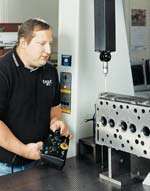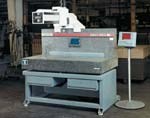Software Charges CMMs
Eagle Manufacturing is a supplier of engine components to Ford Motor Company and Navistar International, a leading manufacturer of trucks, school buses and midrange diesel engines. Eagle’s 120-person facility produces cylinder heads, connecting rods and accessory brackets for diesel engines; lower crankcase housings for gasoline engines; exhaust manifolds for V8 and V6 engines; and 5.4-liter engine blocks.
Eagle Manufacturing (Florence, Kentucky) is a supplier of engine components to Ford Motor Company and Navistar International, a leading manufacturer of trucks, school buses and midrange diesel engines. Eagle’s 120-person facility produces cylinder heads, connecting rods and accessory brackets for diesel engines; lower crankcase housings for gasoline engines; exhaust manifolds for V8 and V6 engines; and 5.4-liter engine blocks.
To produce more than 260,000 of these components per year, the company relies on a Sheffield RS-150 CMM with Sheffnet/OFI and a Sheffield 1808-M CMM with Sheffnet/OFI to perform receiving and in-process operations, final inspections and occasional unscheduled layouts.
Featured Content
Faced with the demand to produce higher volumes of parts in shorter lead times, the company needed to upgrade its existing equipment. Although finished components were of high quality, CMM programming and setup time were routine stumbling blocks to the overall production process. The challenge was to find a solution that would not sacrifice high-level programming flexibility for ease of use and vice versa.
“Programming time was long and slow,” says quality engineer Richard Criswell. “We needed CMM software that was user-friendly, without any restrictions on flexibility. We also had to accommodate a wide range of user experience levels.”
To meet these objectives, Eagle researched four different types of commercial software before choosing the CAMIO and LaunchPad software developed by LK Metrology Systems, Inc. of Brighton, Michigan. “There used to be two types of CMM software available,” Mr. Criswell remarks. “One type was user-friendly and easy to use, but very restrictive, with no depth or flexibility. The other kind was capable of doing any task, but the complex programming required was not supported by the workforce. This is not what we’ve experienced with CAMIO and LaunchPad,” he continues. “They’re easy and enjoyable to use but still have the power to get the task done.”
This flexibility and ease of use is made possible by LK-DMIS. DMIS, or Dimensional Measuring Interface Standard, is a standard programming protocol that supports CMM programming using data pulled directly from the CAD system. DMIS-based software, including CAMIO and LaunchPad, provide a vehicle for efficient bi-directional communication of inspection data between CAD systems and CMMs, thereby easing the measurement task and saving design and verification time.
Eagle retrofitted its Sheffield CMMs with the LK2000 DCC controller and CAMIO and LaunchPad software in the spring of 1999. After installing the upgrades, LK Metrology Systems took responsibility for any services needed on the retrofitted machines. Since then, programming time has been cut in half, and in some cases, measuring operation speed has increased by as much as 75 percent.
Mr. Criswell credits this new efficiency to the software’s user-friendliness. “Operators appreciate how easy it is to use LaunchPad,” he notes. “They enjoy interacting with Windows, and they especially like the CAMIO Graphical Reporting, which provides them with a faster, simpler method for analyzing data.”
CAMIO is a flexible, three-dimensional CMM software suite that provides a direct link between CAD/CAM and inspection operations. The software generates inspection programs from solid, surface or wire-frame CAD data files using a geometric software module for prismatic parts and a surface analysis package for formed parts. The optional graphical reporting feature produces full-color graphic inspection reports based around the component CAD model. LaunchPad allows the operator to carry out various inspection programs using “point and click” capabilities and provides complete component positioning and program launching instructions using a graphic menu.
“The ability to program online and execute each command one at a time, and to stop the program and re-measure has saved us significant time and costs,” states Mr. Criswell. “If you’re halfway through or further when you hit an error, the ability to keep on going can really add up.”
Switching from Sheffield to the new LK2000 controller eliminated all previous service issues and improved reliability. By providing an advanced controller package, LK2000 and CAMIO gave the aging machines all of the capabilities of new CMMs.
Mr. Criswell also identifies faster, easier operator training as a major contributor to higher plant efficiency. “LK software may be used by personnel of all levels of experience,” he says. “Prior to retrofitting, only skilled programmers were able to use the old software effectively. Of all of the programs we considered, only LK’s bridges that gap.”
RELATED CONTENT
-
Reinventing the Wheel with Robot-Automated CNC Multitasking
One race team discovers how to efficiently manufacture a new wheel nut design for the next-generation NASCAR stock car with the help of a CNC mill/turn and a built-in robot.
-
Tooling Up for Micromachining
Choosing the right tools and matching them to the correct operations and process techniques for micromachining applications is critical to success in this burgeoning market.
-
Understanding – and Machining – Ultra-Clean Steel
Using the strongest steel available to create critical automotive powertrain components is necessary and in demand. Understanding how to properly machine ultra-clean steel and executing these techniques will enable cost-efficient and consistent part production.







